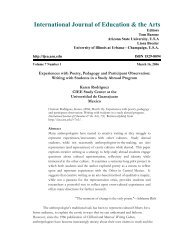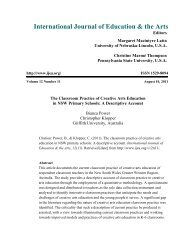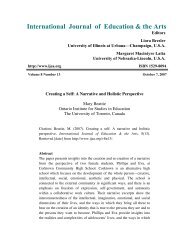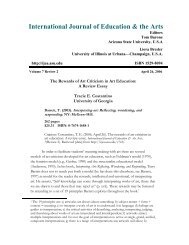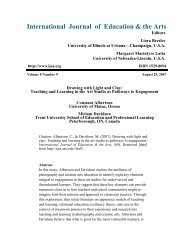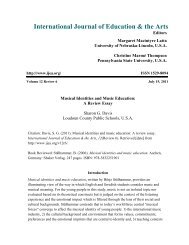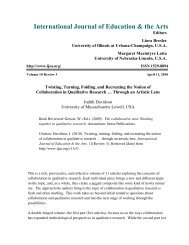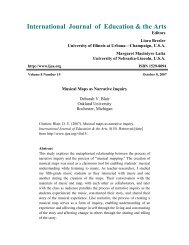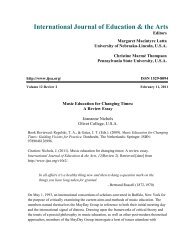On Empathy: The Mirror Neuron System and Art Education
On Empathy: The Mirror Neuron System and Art Education
On Empathy: The Mirror Neuron System and Art Education
You also want an ePaper? Increase the reach of your titles
YUMPU automatically turns print PDFs into web optimized ePapers that Google loves.
IJEA Vol. 10 No. 15 - http://www.ijea.org/v10n15/ 4<br />
human being <strong>and</strong> observed by another. As Iacoboni (2007) explains: “when I see you grasping<br />
something, the same cells in my brain are activated, so it’s almost like I’m in your mind”<br />
(emphasis added).<br />
Also found in area F5 <strong>and</strong> concerned with motor behaviors of the h<strong>and</strong> are the canonical<br />
neurons <strong>and</strong> possibly, the “super mirror neurons” (Iacoboni, 2008). Unlike their mirroring<br />
neighbors, canonical neurons fire at the very sight of a graspable object, invoking in the brain<br />
the “motor plans” necessary to grasp that object (Iacoboni, 2008). Super mirror neurons,<br />
according to Iacoboni’s (2008) hypothesis, suggest a “functional neuronal layer ‘on top’ of the<br />
classical mirror neurons” that controls their activity, increasing or decreasing their firing rates<br />
(p. 203). Important in action observation, ostensibly, super mirror neurons play a role in<br />
differentiating self <strong>and</strong> other, for example, by preventing one’s own h<strong>and</strong> from grasping while<br />
observing the grasping action of another (Iacoboni, 2008). A functional system, the mirror,<br />
canonical, <strong>and</strong> hypothetical super mirror neurons challenge traditional notions about<br />
perception. As the neuroscientist, Vittorio Gallese (2006) points out: “we don’t just perceive<br />
with the visual system, we perceive also with the motor system.” Indeed, action <strong>and</strong><br />
perception are not separate, but inextricably linked in area F5 of the brain (Iacoboni, 2008).<br />
<strong>The</strong> pattern of activity in the mirror neuron system allows human beings to experience their<br />
own actions <strong>and</strong> those of others at an abstract level of representation; that is, through an<br />
“embodied simulation” (Freedberg & Gallese, 2007; Gallese, 2006). Such a motor simulation,<br />
according to Gallese (2006), “allows our body to resonate along with the bodies of others.”<br />
Laying the neurological foundation for empathy, these simulations are critically important in<br />
enabling people to share their experiences <strong>and</strong> underst<strong>and</strong> the h<strong>and</strong>- <strong>and</strong> object-related actions<br />
that characterize the world of objects. Including objects of art <strong>and</strong> material culture, as well as<br />
the h<strong>and</strong> tools used in studio classrooms, this world is resonant in art education.<br />
<strong>The</strong> World of Objects<br />
<strong>The</strong> question of how people underst<strong>and</strong> objects—the things of material life—has been pursued<br />
by philosophers <strong>and</strong> neuroscientists alike. Vischer, <strong>and</strong> later, Merleau-Ponty, for example,<br />
understood objects by experiencing them intimately. For Merleau-Ponty (1964), though,<br />
connections to things were forged in <strong>and</strong> made resonant by the body. In his words: “Things<br />
have an internal equivalent in me. <strong>The</strong>y arouse in me a carnal formula of their presence” (p.<br />
164). Neuroscientific evidence now supports the existentialist notion that things are<br />
understood corporally. Objects induce embodied simulations that represent the acts of<br />
selecting, holding, or manipulating them long associated with human experience <strong>and</strong> cultural<br />
expression. <strong>The</strong> grasping actions <strong>and</strong> “motor plans” necessary to apprehend such objects are,<br />
according to Iacoboni (2008), “inherently linked” to our very underst<strong>and</strong>ing of them (p. 14).




